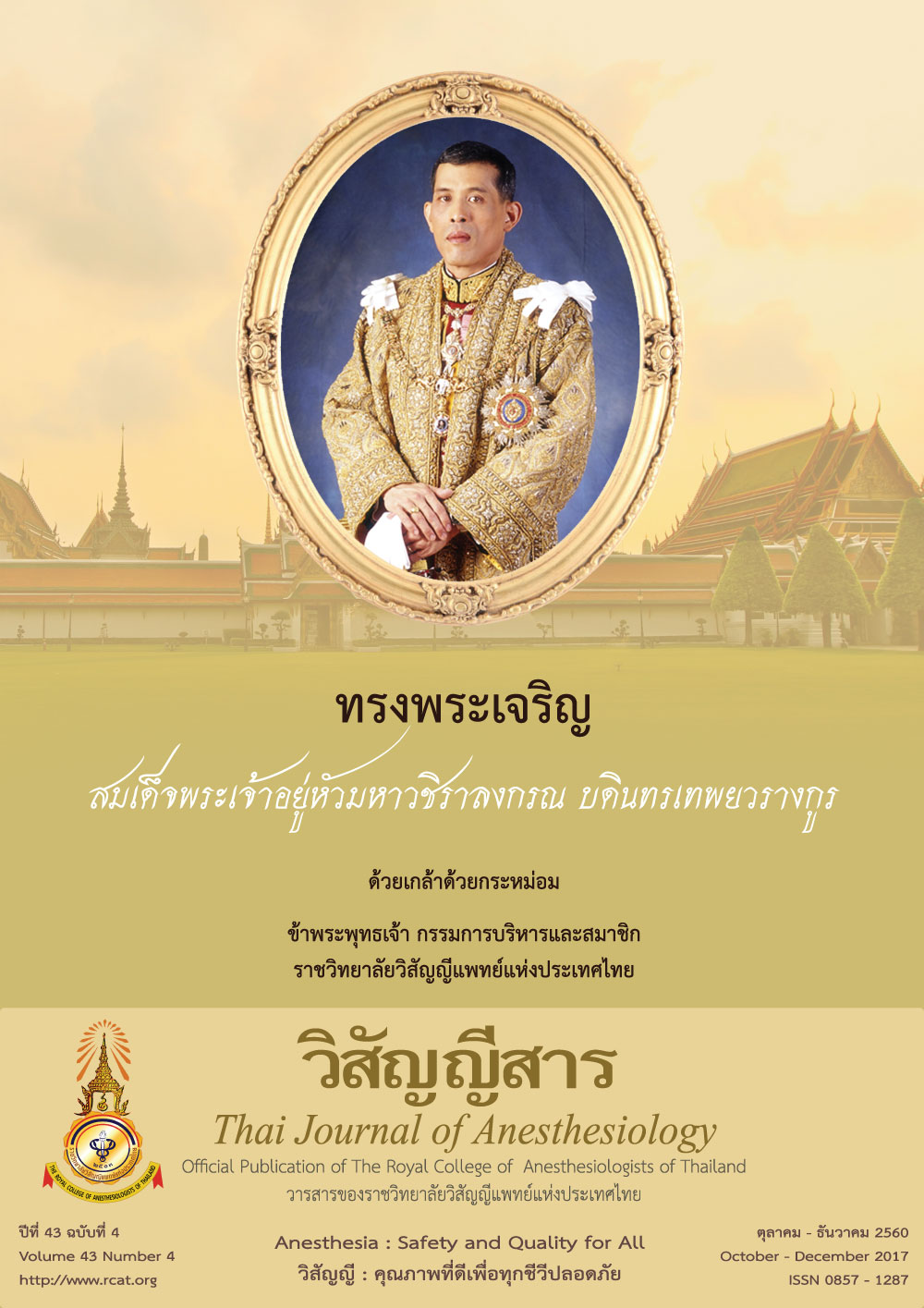The effect of intravenous dexmedetomidine to intrathecal bupivacaine on spinal block duration in orthopedic surgery: a double blind controlled study
Main Article Content
Abstract
Background: Spinal anesthesia is a widely used
technique in patients undergoing lower extremity
orthopedic surgery. However, this technique still has
a limitation on the duration of anesthesia that may
not cover the duration of surgery. Objectives: To
investigate the effects of intravenous dexmedetomidine
on the duration of sensory block of spinal anesthesia
in patients undergoing orthopedic surgery. Methods: In
a prospective, double-blind study, ninety ASA I-III
patients undergoing orthopedic surgery under spinal
anesthesia with 0.5% bupivacaine 15 mg were
randomized to 3 groups. Group D (1) received IV
dexmedetomidine 1 mcg/kg over 10 min after spinal
anesthesia, followed by an infusion of 0.4 mcg/kg/hr
for the duration of surgery. Group D (0.5) received IV
dexmedetomidine 0.5 mcg/kg over 10 min, followed
by an infusion of 0.2 mcg/kg/hr. Group C received
normal saline infusion. The duration of motor and
sensory anesthesia, onset time, maximum block
level, time to first request for postoperative analgesia,
postoperative analgesic requirement, and side effects
were assessed. Results: The duration of motor block
in group D (1) was significantly longer than group C
(253.17 ± 57 vs 210.98 ± 67 min, P = 0.007). Duration
of sensory block increased in dexmedetomidine group but not statistical significance. Intraoperative sedation
was greater in dexmedetomidine group. Time to first
request for postoperative analgesia was longer in
group D (1) than in group C (373.5±195 vs 280.8±98 min,
P=0.018). Onset time, maximum block level, incidence
of hypotension, bradycardia, nausea and vomiting,
postoperative analgesic requirement, and patients
satisfaction were similar in all groups. Conclusion: IV
dexmedetomidine 1 mcg/kg over 10 min after spinal
anesthesia, followed by an infusion of 0.4 mcg/kg/hr,
prolonged motor block of bupivacaine spinal
anesthesia without increased significant adverse effects.
It also provided sedation and increased time to first
request for postoperative analgesia.
Article Details
References
anesthesia for knee surgery. Tech Reg Anesth Pain Manag.
1999;3(2):107-12.
2. Graber R, Kraay M. Regional anesthesia for postoperative
pain control [Internet]. 2010 [update 2017 Dec 11; cited
2018 Jan 16]. Available from: http://emedicine.medscape.
com/article/1268467-overview.
3. Christopher G, Ursula L, Christian S, Gerald I, Christian W,
Stephan CK. Spinal versus general anesthesia for
orthopedic surgery: anesthesia drug and supply costs.
Anesth Analg. 2006;102(2):524-9.
4. Simone DC, Maria R, Andrea C, Caterina C, Guido F.
Spinal anesthesia: an evergreen technique. Acta Biomed.
2008;79(1):9-17.
5. Whitacre RJ, Potter JK. The subarachnoid use of
vasoconstrictors in spinal anesthesia. Ann Surg.
1948;127(2):338-41.
6. Bonica JJ, Backup PH, Pratt WH. The use of
vasoconstrictors to prolong spinal anesthesia.
Anesthesiology. 1951;12(4):431-41.
7. Racle JP, Benkhadra A, Poy JY, Gleizal B. Prolongation
of isobaric bupivacaine spinal anesthesia with epinephrine
and clonidine for hip surgery in the elderly. Anesth Analg.
1987;66(5):442-6.
8. Dobrydnjov I, Axelsson K, Samarutel J, Holmstrom B.
Postoperative pain relief following intrathecal
bupivacaine combined with intrathecal or oral clonidine.
Acta Anaesthesiol Scand. 2002;46(7):806-14.
9. Fogarty DJ, Carabine UA, Milligan KR. Comparison
of the analgesic effects of intrathecal clonidine and
intrathecal morphine after spinal anaesthesia in patients undergoing total hip replacement. Br J Anaesth.
1993;71(5):661-4.
10. Bernard CM. Epidural and spinal anesthesia. In: Barash
PG, editors. Clinical anesthesia. 4th ed. Philadelphia:
Lippincott William & Wilkins; 2001. p. 645-68.
11. Rhee K, Kana K, Kim J, Jeon Y. Intravenous clonidine
prolongs bupivacaine spinal anesthesia. Acta Anaesthesiol
Scand. 2003;47(8):1001-5.
12. Yazbek-Karam VG, Aouad MM. Perioperative uses of
dexmedetomidine. Middle East J Anesthesiol. 2006;
18(6):1043-58.
13. Kanazi GE, Aouad MT, Jabbour-Khoury SI, Al Jazzar
MD, Alameddine MM, Al-Yaman R, et al. Effect of low-
dose dexmedetomidine or clonidine on the characteristics
of bupivacaine spinal block. Acta Anaesthesiol Scand.
2006;50(2):222-7.
14. Al-Mustafa MM, Abu-Halaweh SA, Aloweidi AS,
Murshidi MM, Ammari BA, Awwad ZM, et al. Effect of
dexmedetomidine added to spinal bupivacaine for
urological procedures. Saudi Med J. 2009;30(3):365-70.
15. Al-Ghanem SM, Massad IM, Al-Mustafa MM, Al-Zaben
KR, Qudaisat IY, Qatawneh AM, et al. Effect of adding
dexmedetomidine versus fentanyl to intrathecal
bupivacaine on spinal block characteristics in
gynecological procedures: a double blind controlled
study. Am J Appl Sci. 2009;6(5):882-7.
16. Kaya FN, Yavascaoglu B, Turker G, Yildirim A, Gurbet A,
Mogol EB, Ozcan B. Intravenous dexmedetmidine, but
not midazolam, prolongs bupivacaine spinal anesthesia.
Can J Anaesth. 2010;57(1):39-45.
17. Al-Mustafa MM, Badran IZ, Abu-Ali HM, Al-Barazangi
BA, Massad IM, Al-Ghanem SM. Intravenous
dexmedetomidine prolongs bupivacaine spinal analgesia.
Middle East J Anesthesiol. 2009;20(2):225-31.
18. Tekin M, Kati I, Tomak Y, Kisli E. Effect of
dexmedetomidine iv on the duration of spinal anesthesia
with prilocaine: a double-blind prospective study in
adult surgical patients. Curr Ther Res Clin Exp. 2007;
68(5):313-24.
19. Elcicek K, Tekin M, Kati I. The effects of intravenous
dexmedetomidine on spinal hyperbaric ropivacaine
anesthesia. J Anesth. 2010;24(4):544-8.
20. Whizar-Lugo V, Gomez-Ramirez IA, Cisneros-Corral R,
Martinez-Gallegos N. Intravenous dexmedetomidine
vs. intravenous clonidine to prolong bupivacaine spinal
anesthesia: a double blind study. Anestesia en Mexico.
2007;19(3):143-6.
21. Dosing guidelines for Precedex: nonintubated procedural
sedation and ICU sedation. [cited 2018 Jan 16] Available
from: http://aamsn.org/wp-content/uploads/2010/02/
Precedex_Dosing_Guide.pdf.
22. Berde CB, Strichartz GR. Local Anesthetics. In: Miller RD,
editors. Miller’s Anesthesia. 7th ed. Philadelphia:
Churchill Livingstone; 2010. p. 913-39.
23. Lemeshow S, Hosmer DW, Klar J, Lwanga SK. Adequacy
of sample size in health studies. Chichester: John Willey
& Sons; 1990.
24. Hong J, Kim W, Yoon Y, Choi Y, Kim S, Kil H.
Effects of intravenous dexmedetomidine on low dose
bupivacaine spinal anesthesia in elderly patients. Acta
Anaesthesiol Scand. 2012;56:382-7.
25. Reddy VS, Shaik NA, Donthu B, Sannala VKD, Jangam V.
Intavenous dexmedetomidine versus clonidine for
prolongation of bupivacaine spinal anesthesia and
analgesia: a randomized double-blind study. J Anaesthesiol
Clin Pharmacol. 2013;29(3):342-7.
26. Blood BC, Ward DS, Belleville JP, Maze M. Effects
of intravenous dexmedetomidine in humans. II.
Hemodynamic changes. Anesthesiology. 1997;77:1134-42.
27. Guo TZ, Jiang JY, Buttermann AE, Maze M.
Dexmedetomidine injection into the locus ceruleus
produces antinociception. Anesthesiology. 1996;84:873-81.


